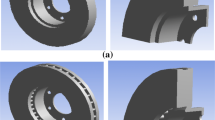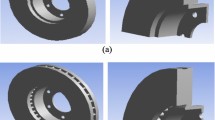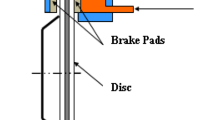Abstract
The braking phenomenon is an aspect of vehicle stopping performance where with kinetic energy due to speed of vehicle is transformed to thermal energy via the friction between the brake disc and its pads. The heat must then be dissipated into the surrounding structure and into airflow around the brake system. The frictional thermal field during the braking phase between the disc and the brake pads can lead to excessive temperatures. In our work, we presented numerical modeling using ANSYS software adapted in the finite element method, to follow the evolution of the global temperatures for the two types of brake discs, full and ventilated disc during braking scenario. Also, numerical simulation of the transient thermal and static structural analysis was performed here sequentially, with coupled thermo-structural method. Numerical procedure of calculation relies on important steps such that the computational fluid dynamics (CFD) and thermal analysis have been well illustrated in 3D, showing the effects of heat distribution over the brake disc. This CFD analysis helped us in the calculation of the values of the heat transfer coefficients (h) that have been exploited in 3D transient evolution of the brake disc temperatures. Two different rotor designs and three different brake disc materials were tested and comparative analysis of the results was conducted in order, to derive the one with the best thermal behavior. Finally, the resolution of the coupled thermomechanical model allows us to visualize other important results of this research such as the deformations, and the equivalent von Mises stress of the disc, as well as the contact pressure of the brake pads. Following the analysis of the results obtained, we drew several conclusions from this investigation. The choice allowed us to deliver the rotor design excellence to ensure and guarantee the good braking performance of the vehicles.









































Similar content being viewed by others
References
R. Leal, F.M. Barreiros, L. Alves, F. Romeiro, J.C. Vasco, M. Santos, C. Marto, Additive manufacturing tooling for the automotive industry. Int. J. Adv. Manuf. Technol. 92, 1671–1676 (2017)
W.H. Li, H. Du, Design and experimental evaluation of a magneto rheological brake. Int. J. Adv. Manuf. Technol. 21, 508–515 (2003)
R. Udayakumar, R. Ponnusamy, Computer aided design and analysis of disc brake rotors for passenger cars, in International Conference on Computer Applications Technology, ICCAT 2013 (2013), pp. 1–5. https://doi.org/10.1109/iccat.2013.6521979
P. Sadagopan, H.K. Natarajan, P. Kumar, Study of silicon carbide-reinforced aluminum matrix composite brake rotor for motorcycle application. Int. J. Adv. Manuf. Technol. 94, 1461–1475 (2018)
Pei-Lum Tso, Rick Hsu, Estimating chemical mechanical polishing pad wear with compressibility. Int. J. Adv. Manuf. Technol. 32, 682–689 (2007)
N.Y. Nguyen, Z.W. Zhong, Y.B. Tian, Analysis and improvement of the pad wear profile in fixed abrasive polishing. Int. J. Adv. Manuf. Technol. 85, 1159–1165 (2016)
C.-C.A. Chen, Q.-P. Pham, Study on diamond dressing for non-uniformity of pad surface topography in CMP process. Int. J. Adv. Manuf. Technol. 91, 3573–3582 (2017)
S. Hasagasioglu, K. Kilicaslan, O. Atabay, A. Güney, Vehicle dynamics analysis of a heavy-duty commercial vehicle by using multibody simulation methods. Int. J. Adv. Manuf. Technol. 60, 825–839 (2012)
M.A. Ashraf, B. Sobhi-Najafabadi, Ö. Göl, D. Sugumar, Numerical simulation of sliding wear for a polymer–polymer sliding contact in an automotive application. Int. J. Adv. Manuf. Technol. 41, 1118–1129 (2009)
K. Salonitis, P. Stavropoulos, A. Kolios, External grind-hardening forces modelling and experimentation. Int. J. Adv. Manuf. Technol. 70(1–4), 523–530 (2014)
P.M. Lerones, J.L. Fernández, J.G. García-Bermejo, E. Zalama, Total quality control for automotive raw foundry brake disks. Int. J. Adv. Manuf. Technol. 27, 359–371 (2005)
Y.A. Çengel, A.J. Ghajar, Heat and Mass Transfer: Fundamentals & Applications (McGraw-Hill, New York, 2011)
A. Belhocine, N.M. Ghazaly, Effects of young’s modulus on disc brake squeal using finite element analysis. Int. J. Acoust. Vib. 31(3), 292300 (2016)
M.R. Ishak, A.R. Abu Bakar, A. Belhocine, J.M. Taib, W.Z. Wan Omar, Brake torque analysis of fully mechanical parking brake system: Theoretical and experimental approach. Ing. Investig. Tecnol. 19(1), 37–49 (2018)
J.H. Choi, I. Lee, Transient thermoelastic analysis of disk brakes in frictional contact. J. Therm. Stress. 26(3), 223–244 (2003)
J.H. Choi, I. Lee, Finite element analysis of transient thermoelastic behaviors in disk brakes. Wear 257(1–2), 47–58 (2004)
Y. Yildiz, M. Duzgun, Stress analysis of ventilated brake discs using the finite element method. Int. J. Automot. Technol. 11(1), 133–138 (2010)
Adam Adamowicz, Piotr Grzes, Influence of convective cooling on a disc brake temperature distribution during repetitive braking. Appl. Therm. Eng. 31(14–15), 2177–2185 (2011)
M. Duzgun, Investigation of thermo-structural behaviors of different ventilation applications on brake discs. J. Mech. Sci. Technol. 26(1), 235–240 (2012)
M. Pevec, Prediction of the cooling factors of a vehicle brake disc and its influence on the results of a thermal numerical simulation. Int. J. Automot. Technol. 13(5), 725–733 (2012)
P. Hwang, X. Wu, Investigation of temperature and thermal stress in ventilated disc brake based on 3d thermo-mechanical coupling model. J. Mech. Sci. Technol. 24(1), 81–84 (2010)
M.J. Han, C.H. Lee, T.W. Park, S.P. Lee, Low and high cycle fatigue of automotive brake discs using coupled thermo-mechanical finite element analysis under thermal loading. J. Mech. Sci. Technol. 32(12), 5777–5784 (2018)
M.J. Han, C.H. Lee, T.W. Park, J.M. Park, S.M. Son, Coupled thermo-mechanical analysis and shape optimization for reducing uneven wear of brake pads. Int. J. Automot. Technol. 18(6), 1027–1035 (2017)
P. Dufrénoy, D. Weichert, Prediction of railway disc brake temperatures taking the bearing surface variations into account. Proc. Inst. Mech. Eng. Part F J. Rail Rapid Transit 209(2), 67–76 (1995)
E. Palmer, R. Mishra, J.D. Fieldhouse, An optimization study of a multiple row pin vented brake disc to promote brake cooling using computational fluid dynamics. Proc. Inst. Mech. Eng. Part D J. Automob. Eng. 223(7), 865–875 (2009)
J. Reimpel, Braking Technology (Vogel Verlag, Würzburg, 1998)
C. Cruceanu, Frâne pentru vehicle feroviare (Brakes for railway vehicles), Ed. MATRIXROM, Bucureşti (2007). ISBN: 978-973-755-200-6
H. Dittrich, R. Lang, Finite-Element Analysis of the thermal loads acting on a passenger car brake disk. Automob. Z. 86(6), 265–269 (1984)
A. Fukano, H. Matsui, Development of disc-brake design method using computer simulation of heat phenomena, SAE 860634 (1986)
P.F. Gotowicki, V. Nigrelli, G.V. Mariotti, D. Aleksendric, C. Duboka, Numerical and experimental analysis of a pegs-wing ventilated disk brake rotor with pads and cylinders, in 10th EAEC European Automotive Congress—Paper EAEC05YUAS04–P5 (2005)
K. Rajesh, Transient thermoelastic analysis of disk brake using ANSYS software, M.Tech thesis, Thapar University, 2008
R. Limpert, Brake Design and Safety, 3rd edn. (SAE International, Warrendale, 2011), pp. 1–112
M.K. Khalid, M.R. Mansor, S.I. Abdul Kudus, M.M. Tahir, M.Z. Hassan, Performance investigation of the UTeM eco-car disc brake. Syst. Int. J. Eng. Technol. 11(6), 1–6 (2011)
R. Limpert, Brake Design and Safety, 2nd edn. (Society of Automotive Engineering Inc., Warrendale, 1999), pp. 137–144
M. Burckhardt, Fahrwerktechnik: Bremsdynamik und PKW-Bremsanlagen (Vogel Buchverlag, Würzburg, 1991)
J. Zhang, C. Xia, Research of the transient temperature field and friction properties on disc brakes, in Proceedings of the 2012 2nd International Conference on Computer and Information Application (ICCIA 2012) (2012), pp. 201–204
T.J. Mackin, S.C. Noe, K.J. Ball, B.C. Bedell, D.P. Bim-Merle, M.C. Bingaman, D.M. Bomleny, G.J. Chemlir, D.B. Clayton, H.A. Evans, Thermal cracking in disc brakes. Eng. Fail. Anal. 9, 63–76 (2002)
G. Oder, M. Reibenschuh, T. Lerher, M. Šraml, B. Šamec, I. Potrč, Thermal and stress analysis of brake discs in railway vehicles. Adv. Eng. 3(1), 95–102 (2009)
N. Coudeyras, Non-linear analysis of multiple instabilities to the rubbing interfaces: application to the squealing of brake, PhD Thesis, Central school of Lyon-speciality: mechanics, 2009
A.R. Abu Bakar, H. Ouyang, L.C. Khai, M.S. Abdullah, Thermal analysis of a disc brake model considering a real brake pad surface and wear. Int. J. Veh. Struct. Syst. 2(1), 20–27 (2010)
Stephens, A. Aerodynamic cooling of automotive disc brakes, Master’s thesis, School of Aerospace, Mechanical and Manufacturing Engineering, RMIT University, 2006
Author information
Authors and Affiliations
Corresponding author
Ethics declarations
Conflict of interest
The authors declare that there is no conflict of interest.
Additional information
Publisher's Note
Springer Nature remains neutral with regard to jurisdictional claims in published maps and institutional affiliations.
Appendices
Appendix 1
Calculating Heat Flux Entering the Disc
The Forces Acting on the Wheels During Braking
By observing the situation described in Fig. 40, the longitudinal and transverse equilibrium of the vehicle can be written along the local axes x, y of the car.
with \(F_{\text{F}} = F_{\text{FV}} + F_{\text{FH}}\), \(F_{\text{RR}} = F_{\text{RRV}} + F_{\text{RRH}}\)
On a road vehicle, the rolling force FRR = FGfr cos α is due to the flat formed by a tire on the road fr is the rolling resistance coefficient. For a high pressure tire (fr = 0.015).
The aerodynamic force is given by:
With CX is the coefficient of form, equal to: 0.3 to 0.4 on the car, AF (m2) is the frontal surface; on the approach, for a road passenger vehicle, we can take: AF = 0.8 × height × width S and ρa is the air density.
Total Braking Power
By
In the case of flat braking (Fig. 41), the resistances due to rolling and the slope are neglected (FRR = 0 and FRP = 0), the penetration into the air is generally negligible, for this reason (FRA = 0)
If we define, Let ϕ the factor of the ratio of the braking power with respect to the rear wheels PFH = ϕmav then, PFV = (1 − ϕ)mav.
If a is constant, we have:
The braking power delivered to the brake disc is equal to half the total power:
At time t = 0, we have
The braking efficiency is then defined by the ratio between the deceleration (a) and the acceleration (g):
Assuming that the amount of heat generated by friction is completely absorbed by the disc.
The expression of the transformed friction power per unit area is thus:
The quantity \(Q_{v}^{\prime }\) indicates the heat flow absorbed by the disc, which must be housed only on the actual contact surface. Where Ad is the surface of the rotor to which a brake pad pivots.
By definition, the operating factor εp of the friction surface is given by the following formula:
Thus, the equation of the initial thermal flow of friction entering the disc, which is calculated as follows:
Appendix 2
Analysis of Disc Rotor Force
A free body diagram of a front wheel-rotor system, Fig. 42, is used to drive the equation of equilibrium. Since large amount of the braking load is born by the front brakes, that amount of kinetic energy and potential energy into a single disc is given by
But \(S_{b} = \frac{{v_{0}^{2} }}{2a}\)
The power dissipated by each rotor face is equal to the heat flux into the rotor face.
But from kinematic relationships.
\(F_{\text{rotor}}\) is constant with respect to time, and \(v_{\text{rotor}}\) varies only linearly with time so the energy balance equation becomes:
When braking on a straight/flat track (α = 0), k is estimated to be about 0.30. Therefore, Eq 59 should be modified to be:
Rights and permissions
About this article
Cite this article
Belhocine, A., Abdullah, O.I. Design and Thermomechanical Finite Element Analysis of Frictional Contact Mechanism on Automotive Disc Brake Assembly. J Fail. Anal. and Preven. 20, 270–301 (2020). https://doi.org/10.1007/s11668-020-00831-y
Received:
Published:
Issue Date:
DOI: https://doi.org/10.1007/s11668-020-00831-y







